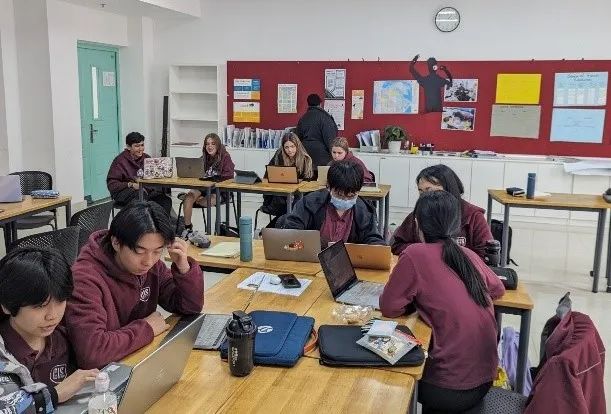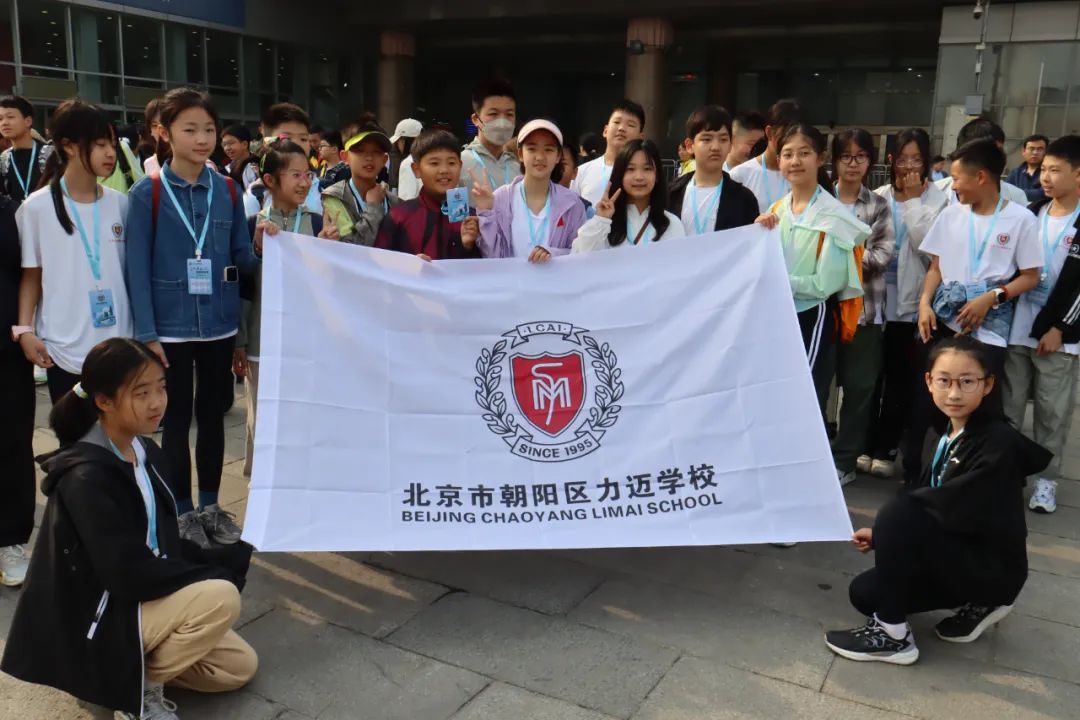02-06 08:37发布于安徽
Individuals and Societies Highlights
CISH

This week grade 6 Individuals and Societies students were introduced to world religions. They worked in pairs to interpret and analyze a table of with information about various religions including number of followers, beliefs, and rituals. They also used a map of the distribution of world religions to practice reading maps and explaining how religion may spread. Students took notes on some of the beliefs of major world religions.



This week in grade 7 Individuals and Societies class students continued working on their unit 2 summative research project. The students have been working on the first rough draft of their essay, using their outline and a sample essay as a guide. They are working on their communication and self-management skills.


This week in grade 8 Individuals and Societies class students are working on a mid-unit summative to show their knowledge and understanding of natural resources and their use. The students have the choice of product they will create to show their understanding. They are working on their communication and self-management skills.


This week in grade 9 Individuals and Societies class students are finishing their second unit on The Medieval World by completing a unit specific summative. They were tasked with creating a poster that demonstrates their understanding of the Feudal System and the Role of the Church during the Middle Ages. The students need to explain what the systems are as well as diagram the structure and hierarchy of the 2 systems. They are working on their communication and self-management skills.




Psychology
This week the Grade 11 Psychology students expanded their understanding of the frontal lobe of the brain by exploring the role and function of the prefrontal cortex (PFC) in aggression and decision making. They used a study conducted by Grafman on the impact of damage to the PFC to support the idea that this region plays a role in aggressive behavior. Students were introduced to the Dual Processing Model in cognitive psychology by attempting various cognitive tasks designed to elicit System 1 or System 2 thinking.



The Grade 12 Psychology students spent the week preparing for their upcoming Paper 3 assessment. They reviewed quantitative research methods and identified two key characteristics of each method. They practiced reading summaries of studies and identified the research method and sampling method and suggesting an additional research method for the study. They practiced answering additional Paper 3 questions and read exemplary responses. Both HL and NB students chose which approach they would focus most on for their assessment and began to identify which studies they needed to review and which they could use to support various topics.
This week students covered Nationalism in detail, and created national identity posters to show how symbols and cultural customs can build toward a national identity. We also discussed the battles of the mid part of WW1 like Verdun, the Somme and the Brusilov offensive. Finally, we covered the Russian Revolution and the entry of the United States into WW1.
Slide pictures to see more
Business Management
Grade 11: Work continues of Final Accounts with HL students studying Depreciation techniques. This part of the course requires students to practice their understanding through rigorous practice tests as it forms a core part of their exams (paper 2) in 2025.
Grade 12: Classes have been disrupted to many students being unwell accordingly we have been reviewing the exam materials inn detail but have also started the final concept and business toll in the course, Absorption Costing, namely allocating fixed costs across multiple products. To keep the revision programme interesting and challenging, students will be working on Case Studies as a test of their overall understanding.
The Case Study for the final exam arrived on Friday and students can start reviewing it in preparation for the finals.



Global Politics
Grade 11: This week students continued covering human rights, examining how approaches to rights have evolved over time and in different contexts, and how some of these rights have been codified into international law. We examined historical human rights violations like torture, slavery and child labour, and the political movements and reforms that addressed these issues. We also examined the case study of the Israel-Palestine issue and the ongoing case brought by South Africa against Israel pertaining to the genocide convention.


Grade 12: This week, students were given back their midterm exams and we had discussions on best practices for answering paper 1 style exam questions. Students also began working on a conflict analysis presentation summative, in which students will pick a modern major violent conflict and categorize it based on the terms we have covered this unit, like interest based conflict vs identity based conflict, and sub-state actors vs state actors. On Thursday we did not have class as students were celebrating the Chinese New Year events and volunteering at booths for charitable causes and promoting their student societies like the Zoology club.
Design Highlights
CISH

In MYP Grade 6 Design, students dedicated the week to refining their design ideas in accordance with Criteria B for Unit 2. This involved a thorough examination and adjustment of concepts based on initial research findings. Concurrently, students crafted detailed success criteria for their products, fostering critical thinking about functionality and aesthetics. The collaborative group work persisted, emphasizing teamwork and effective communication. This holistic approach not only advanced technical design skills but also nurtured essential interpersonal and collaborative abilities, preparing students for future challenges in the field of design and beyond.
In the grade 7 class this week, students completed the last strand of Criteria B by meticulously sketching detailed representations of their final chosen products, incorporating intricate details crucial for the project's success. Subsequently, they embarked on the development of detailed logical plans, crafting step-by-step guides that will serve as roadmaps during the actual creation of their products. This process not only enables students to visualize their ideas but also encourages thoughtful planning, fostering critical thinking and problem-solving skills.
In the grade 8 class this week, students delved into the creation of detailed logical plans as they undertook the development of their educational toys. They meticulously crafted step-by-step guides, serving as comprehensive roadmaps for the forthcoming stages of product creation. This approach not only facilitates the visualization of their ideas but also instills a sense of thoughtful planning, nurturing critical thinking, and honing problem-solving skills among the students. As they progress in bringing their educational toys to life, these logical plans will be instrumental in guiding their efforts and ensuring a structured and successful execution of their projects.
In unit 2 of their curriculum, the grade 9 students initiated their exploration of the wooden furniture unit this week. Taking their first steps, they made important decisions regarding team formations and outlined the designs they are enthusiastic about bringing to life. With their teams and design concepts established, the students commenced the creation of problem statements, a crucial step that lends purpose and direction to their ideas. Crafting these problem statements not only helps articulate the challenges they aim to address with their wooden furniture designs but also sets the groundwork for a focused and meaningful approach as they embark on the creative process in the coming weeks.
This week the grade 10s explored the use of arrays in Java coding. An array is a Java structure that holds a fixed number of values of a single type. Students learned how they might want to use arrays to allow us to store multiple elements of the same type in a single array or to use arrays for sorting, searching, accessing, and manipulating data.

Grade 11: This week the grade 11 students are working their way through the last four sub-topics from unit D.1 - Objects as a programming unit. These sub-topics finish our introduction to Object-oriented Programming as we explore the need to reduce dependencies between objects and construct related objects. Data types and how they are passed as parameters are also examined.



Grade 12: This week grade 12 students covered the remaining data transmission sub-topics of Topic 3 - Networks. Students considered the speed of data transmission, the compression of data, and characteristics of different transmission media. At a more physical level, they studied packet switching concepts and network topology. The HL students continued with our weekly examination of past paper 3 case studies.


PYP Highlights
PYP
Class Photos




Grade 1
Ms. Victoria Quercia and Ms. Katherine Turner
The children have been working really hard in their Mandarin classes, and it showed in their great performance in the Chinese New Year show this week!
In math, we have been learning about ‘Probability’ and using key words to describe likelihood of events happening. The children have learned how to describe Probability using the terms “Certain”, “More Likely”, “Equally Likely”, “Less likely”, “Possible” and “Impossible”.


Grade 2
Ms. Camila Kemeny Larrondo and Mr. Steven Davies
This week marked the culmination of our "How We Express Ourselves" unit in Grade 2, where students explored art in various cultures. The highlight of the week was the showcase held for parents, providing a platform for students to share their research findings, artistic creations, and the integration of math concepts inspired by different cultures as well as work from their Visual Arts class. We had groups studying different cultures from all different continents, we are so proud of their open-mindedness and hard work!




Grade 3
Mr. Jeremy Boudreau and Ms.Kelly House
During an engaging week of Language Arts, students delved into the art of persuasive writing, honing their skills in crafting compelling arguments and effectively conveying their opinions. The week we started to look at the principles of persuasive writing, exploring signal words and useful vocabulary, as well as how to hook the reader. As the week progressed, students actively participated in a debate, applying the acquired knowledge to articulate and defend their viewpoints. This hands-on experience not only allowed them to practice persuasive speaking but also fostered critical thinking and effective communication skills. Additionally, the students learned the how to structure their writing into clear paragraphs. They gained insights into organizing their ideas coherently and logically. By the end of the week, the students produced their first piece of persuasive writing of the unit.





Grade 4
Adam Fell and Carla Du Toit
This week at school our school hosted the Chinese New Year celebration. It was a vibrant celebration of cultural diversity, featuring Grade 4 students who adorned traditional clothing representing various regions of China. From the elaborate Hanfu of the Han Chinese to the intricate costumes of ethnic minorities like the Yi, Zhuang, and Miao, each ensemble showcased the rich cultural heritage of China. With confident performances and stunning attire, the Grade 4 students captivated the audience, sharing a short greeting introducing their costumes. The concert served as a reminder of the power of artistic expression in fostering cultural appreciation and community unity. Well done grade 4 students on a fantastic job!
Slide pictures to see more
Grade 5
Ms. Patricia Larrondo and Mr. Matthew Facey
PYP EXHIBITION: Week 2
INQUIRY
Grade 5s this week have been working hard developing their top-tier PYP Exhibition elements for their chosen topics. Students are reflecting about how to express their topics in well written Central Ideas, and beginning to formulate their Lines of Inquiry (LOI), and Key Concepts that relate to their LOIs. Students are also meeting with their Mentors who help guide them in formulating and suggesting Action Plans for future weeks. Students are also choosing an appropriate United Nations Sustainable Development Goal (UNSDG) that aligns best with their topics, and writing descriptive justifications for their choices.
Next week is week 3. There is only 3 days in week 3, since our Chinese New Year holiday break begins on Wednesday of next week. So, students will be under pressure to make up for those 2 lost days! Next week students will be finalizing their Key Concept, Learner Profile and ATL choices for their projects!
Thank you Mentors and Parents for your ongoing support for our students during this very important Unit, the PYP Exhibition!
In Mathematics this week, students are starting some multiplication (times tables) and division review, especially reviewing long division. We are also finishing up Angles and ending the Geometry mini unit. We have learned a times table game called “Around The World” where students compete against each other to find out who is the multiplication times table master!
In Language Arts, grade 5 is completing their Explanatory/Expository writing unit. Students are reading every day and learning how to find, record, and properly references their research, as well as writing proper citations for sources collected. Students will be reviewing how to write proper informative and descriptive paragraphs to further support their PYPX research summarizing.

声明:本文内容为国际教育号作者发布,不代表国际教育网的观点和立场,本平台仅提供信息存储服务。
全国500所国际学校大全 / 3分钟匹配5-8所 / 1年名校升学备考托管服务





